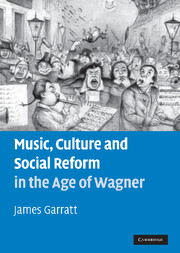Book contents
- Frontmatter
- Contents
- Acknowledgments
- Abbreviations
- Introduction
- 1 Liberalism, autonomy and the social functions of art
- 2 Radical and social aesthetics in the Vormärz
- 3 Speaking for the Volk: music, politics and Vormärz festivals
- 4 Revolutionary voices: blueprints for an aesthetic state
- 5 Music and the politics of post-revolutionary culture
- 6 The song of the workers: idylls and activism
- Notes
- Bibliography
- Index
6 - The song of the workers: idylls and activism
Published online by Cambridge University Press: 05 July 2011
- Frontmatter
- Contents
- Acknowledgments
- Abbreviations
- Introduction
- 1 Liberalism, autonomy and the social functions of art
- 2 Radical and social aesthetics in the Vormärz
- 3 Speaking for the Volk: music, politics and Vormärz festivals
- 4 Revolutionary voices: blueprints for an aesthetic state
- 5 Music and the politics of post-revolutionary culture
- 6 The song of the workers: idylls and activism
- Notes
- Bibliography
- Index
Summary
For all their concern with cultivating the masses, many of the reformers discussed so far gave little practical attention to working-class music-making and musical consumption. Just as the working classes and their music are largely ignored in nineteenth-century musical discourse, so they tend to be marginalized in modern studies of the music of this period, or at least assumed to be irrelevant to the dominant culture of the middle classes and the mainstream of musical development. In this study too, we have so far encountered the workers only in peripheral and anonymous roles: as passive recipients of the ministrations of middle-class reformers, or as bystanders catching glimpses of a culture that demanded more money and leisure time than they possessed. From the 1840s, however, an increasingly large number of workers took an active part in music-making, and by the end of the century the working men's choral movement – like its middle-class counterpart – had become a mass organization.
Our main concern is with the social and aesthetic ideals underpinning this movement, in particular the place of choral singing in the workers' associations and parties that were formed in the 1860s: the Allgemeine Deutsche Arbeiterverein or ADAV (General Association of German Workers), the earliest social democratic party in Europe, founded by Ferdinand Lassalle in 1863; and the more moderate Verband Deutsche Arbeitervereine or VDAV (Association of German Workers' Societies), founded in the same year, which was transformed in 1869 under the leadership of August Bebel into the Sozialdemokratischen Arbeiterpartei or SDAP (Social-Democratic Workers' Party).
- Type
- Chapter
- Information
- Music, Culture and Social Reform in the Age of Wagner , pp. 197 - 215Publisher: Cambridge University PressPrint publication year: 2010
- 1
- Cited by



